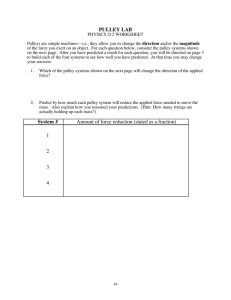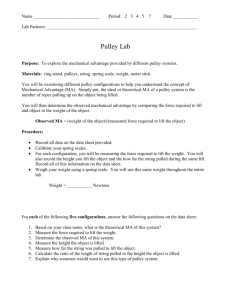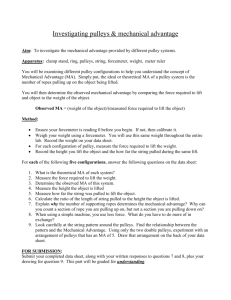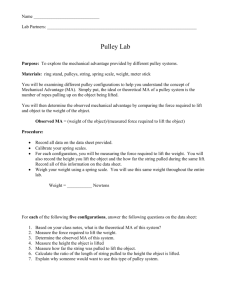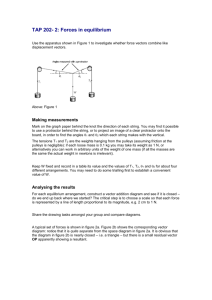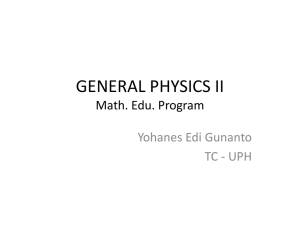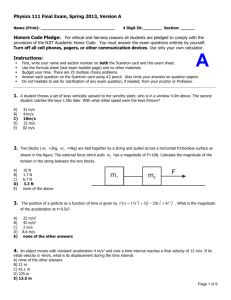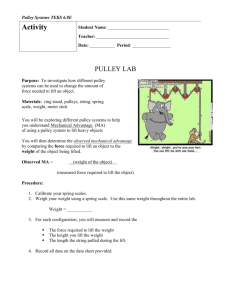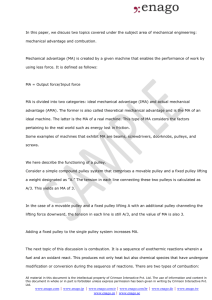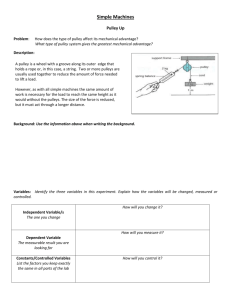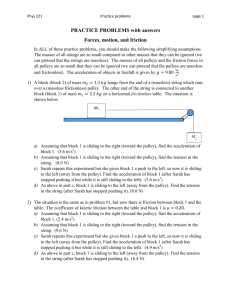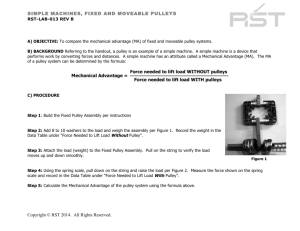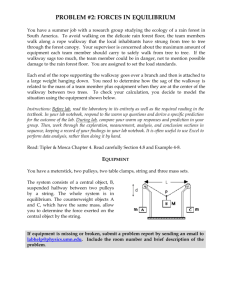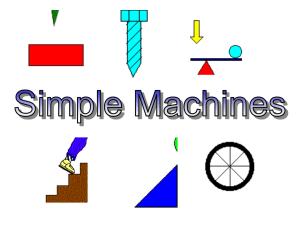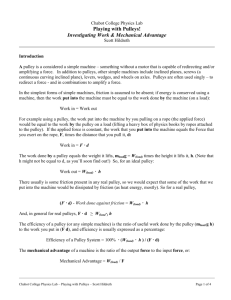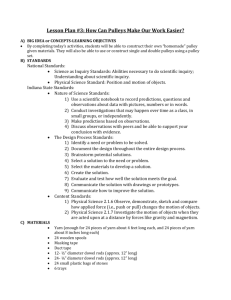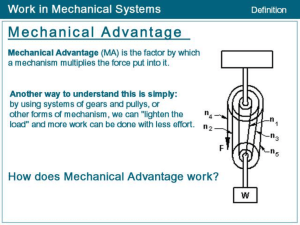MASSACHUSETTS INSTITUTE OF TECHNOLOGY
advertisement
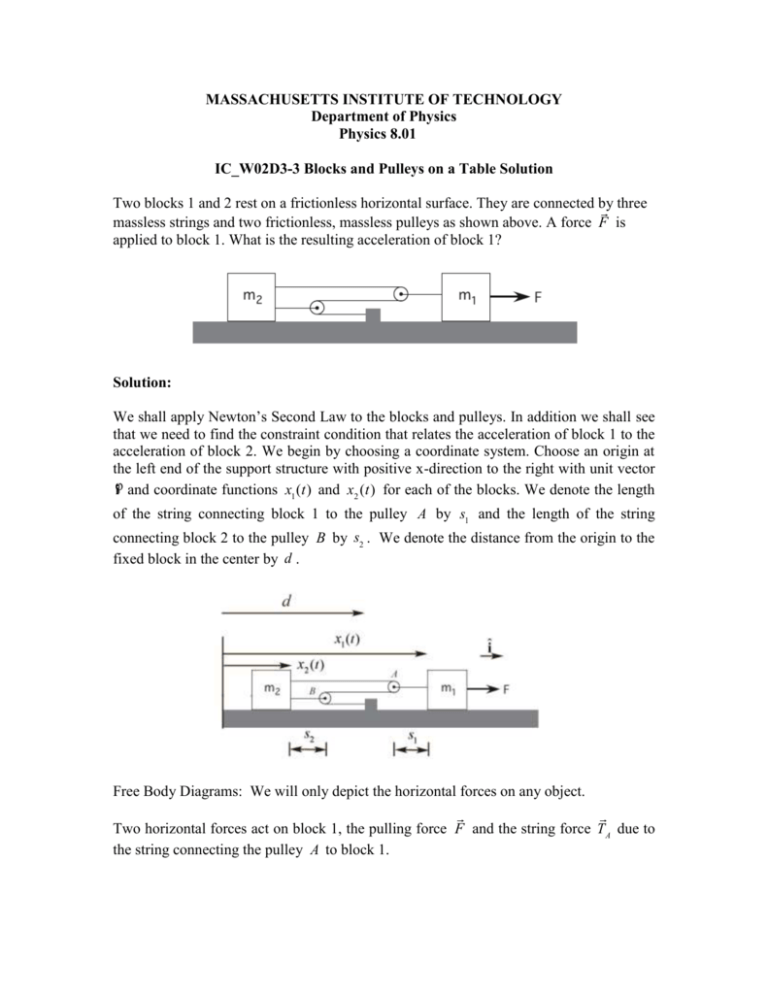
MASSACHUSETTS INSTITUTE OF TECHNOLOGY Department of Physics Physics 8.01 IC_W02D3-3 Blocks and Pulleys on a Table Solution Two blocks 1 and 2 rest on a frictionless horizontal surface. They are connected by three massless strings and two frictionless, massless pulleys as shown above. A force F is applied to block 1. What is the resulting acceleration of block 1? Solution: We shall apply Newton’s Second Law to the blocks and pulleys. In addition we shall see that we need to find the constraint condition that relates the acceleration of block 1 to the acceleration of block 2. We begin by choosing a coordinate system. Choose an origin at the left end of the support structure with positive x-direction to the right with unit vector φ i and coordinate functions x1 (t) and x2 (t) for each of the blocks. We denote the length of the string connecting block 1 to the pulley A by s1 and the length of the string connecting block 2 to the pulley B by s2 . We denote the distance from the origin to the fixed block in the center by d . Free Body Diagrams: We will only depict the horizontal forces on any object. Two horizontal forces act on block 1, the pulling force F and the string force T A due to the string connecting the pulley A to block 1. Newton’s Second Law on block 1 is then F TA m1 d 2 x1 dt 2 . (1) Two horizontal forces act on block 2, the tension T due to string that is wrapped around the two pulleys and the tension TB due to the string connecting the pulley B to block 2. Newton’s Second Law on block 2 is then T TB m2 d 2 x2 dt 2 . (2) The force diagram on pulley A is shown below Since pulley A is massless, Newton’s Second Law becomes TA 2T 0 . Similarly the force diagram on pulley B is (3) Since pulley B is also massless, Newton’s Second Law becomes 2T TB 0 . (4) 2T TB TA (5) Thus we have that and the force equations for the blocks become F 2T m1 3T m2 d 2 x1 (6) dt 2 d 2 x2 (7) dt 2 We have two equations and three unknowns, the tension T , and the two accelerations d 2 x1 / dt 2 , and d 2 x2 / dt 2 . We need to find an additional condition relating the accelerations. The string that wraps around the pulleys is constant in length, hence the first and second derivatives of the length are zero d 2l 0 (constraint condition). dt 2 (8) We need to express the length l of the string in terms of x1 (t) and x2 (t) apply the constraint condition. d 2l 0. dt 2 (9) We shall examine each leg of the string and express the length of that leg in terms of the quantities shown in our coordinate system. We first note that the distance between the blocks is given by (x1 x2 ) . The upper leg has length lupper (x1 x2 ) s1 , (10) lmiddle (x1 x2 ) (s1 s2 ) , (11) the middle leg has length and the lower leg has length llower (d x2 ) s2 . (12) Let the R denote the radius of the pulleys, then we must also include the wrap around length lwrap 2 R . (13) So the length of the string is l lupper lmiddle llower lwrap (x1 x2 ) s1 (x1 x2 ) (s1 s2 ) (d x2 ) s2 2 R (14) Now when we take two derivatives all constant terms vanish because the derivative of a constant is zero. Hence d 2 x1 d 2 x2 d 2l 0 2 2 2 3 2 . dt dt dt (15) Therefore the accelerations satisfy d 2 x1 2 3 d x2 . 2 dt 2 dt 2 (16) We now solve Eqs. (6), (7), and (16) for the accelerations. We begin by substituting d 2 x2 d 2 x1 3 d 2 x2 into Eq. (6) yielding T m2 2 / 3 and 2 dt 2 dt dt 2 2 2 2 d x2 3 d x2 . F m2 2 m1 3 2 dt 2 dt (17) Thus d 2 x2 dt 2 2F / 3 . 4 (m1 m2 ) 9 F . 4 (m1 m2 ) 9 (18) Finally d 2 x1 dt 2 (19)
